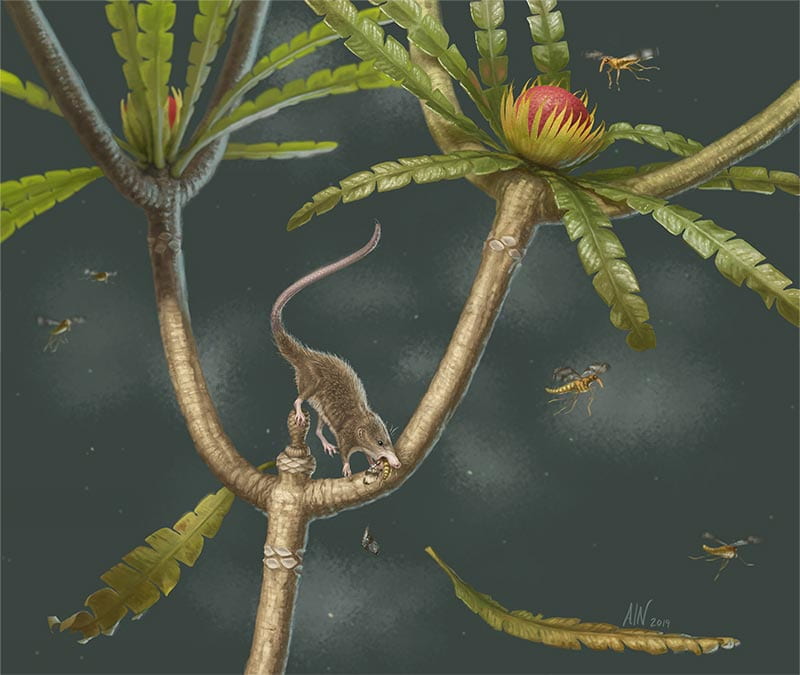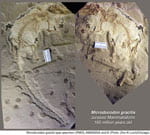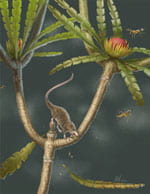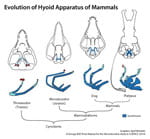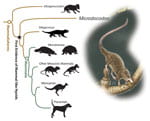Zhou, C.-F. Bhullar, B.-A. S., Neander, A. I., Martin, T. and Z.-X, Luo. 2019. New Jurassic mammaliaform sheds light on early evolution of mammal-like hyoid bones. Science. 365: 276-279. (doi: 10:1126/science.aau9345)
Abstract
Press Release
Jurassic fossil shows how early mammals could swallow like their modern descendants
By Matt Wood
Discovery of a new fossil in China sheds light on when early mammal ancestors first evolved sophisticated hyoid bones that gave them the ability to swallow food like modern-day mammals.
The 165-million-year-old fossil of Microdocodon gracilis, a tiny, shrew-like animal, shows the earliest example of modern hyoid bones in mammal evolution.
The hyoid bones link the back of the mouth, or pharynx, to the openings of the esophagus and the larynx. The hyoids of modern mammals, including humans, are arranged in a “U“ shape, similar to the saddle seat of children’s swing, suspended by jointed segments from the skull. It helps us transport and swallow chewed food and liquid – a crucial function on which our livelihood depends.
Mammals as a whole are far more sophisticated than other living vertebrates in chewing up food and swallowing it one small lump at a time, instead of gulping down huge bites or whole prey like an alligator.
“Mammals have become so diverse today through the evolution of diverse ways to chew their food, weather it is insects, worms, meat, or plants. But no matter how differently mammals can chew, they all have to swallow in the same way,” said Zhe-Xi Luo, PhD, a professor of organismal biology and anatomy at the University of Chicago and the senior author of a new study of the fossil, published this week in Science.
“Essentially, the specialized way for mammals to chew and then swallow is all made possible by the agile hyoid bones at the back of the throat,” Luo said.
‘A pristine, beautiful fossil’
This modern hyoid apparatus is mobile and allows the throat muscles to control the intricate functions to transport and swallow chewed food or drink fluids. Other vertebrates also have hyoid bones, but their hyoids are simple and rod-like, without mobile joints between segments. They can only swallow food whole or in large chunks.
When and how this unique hyoid structure first appeared in mammals, however, has long been in question among paleontologists. In 2014, Chang-Fu Zhou, PhD, from the Paleontological Museum of Liaoning in China, the lead author of the new study, found a new fossil of Microdocodon preserved with delicate hyoid bones in the famous Jurassic Daohugou site of northeastern China. Soon afterwards, Luo and Thomas Martin from the University of Bonn, Germany, met up with Zhou in China to study the fossil.
“It is a pristine, beautiful fossil. I was amazed by the exquisite preservation of this tiny fossil at the first sight. We got a sense that it was unusual, but we were puzzled about what was unusual about it,” Luo said. “After taking detailed photographs and examining the fossil under a microscope, it dawned on us that this Jurassic animal has tiny hyoid bones much like those of modern mammals.”
This new insight gave Luo and his colleagues added context on how to study the new fossil. Microdocodon is a docodont, from an extinct lineage of near relatives of mammals from the Mesozoic Era called mammaliaforms. Previously, paleontologists anticipated that hyoids like this had to be there in all of these early mammals, but it was difficult to identify the delicate bones. After finding them in Microdocodon, Luo and his collaborators have since found similar fossilized hyoid structures in other Mesozoic mammals.
“Now we are able for the first time to address how the crucial function for swallowing evolved among early mammals from the fossil record,” Luo said. “The tiny hyoids of Microdocodon are a big milestone for interpreting the evolution of mammalian feeding function.”
New insights on mammal evolution as a whole
Luo also worked with postdoctoral scholar Bhart-Anjan Bhullar, PhD, now on the faculty at Yale University, and April Neander, a scientific artist and expert on CT visualization of fossils at UChicago, to study casts of Microdocodon and reconstruct how it lived.
The jaw and middle ear of modern mammals are developed from (or around) the first pharyngeal arch, structures in a vertebrate embryo that develop into other recognizable bones and tissues. Meanwhile, the hyoids are developed separately from the second and the third pharyngeal arches. Microdocodon has a primitive middle ear still attached to the jaw like that of other early mammals like cynodonts, which is unlike the ear of modern mammals. Yet its hyoids are already like those of modern mammals.
“Hyoids and ear bones are all derivatives of the primordial vertebrate mouth and gill skeleton, with which our earliest fishlike ancestors fed and respired,” Bhullar said. “The jointed, mobile hyoid of Microdocodon coexists with an archaic middle ear — still attached to the lower jaw. Therefore, the building of the modern mammal entailed serial repurposing of a truly ancient system.”
The tiny, shrew-like creature likely weighed only 5 to 9 grams, with a slender body, and an exceptionally long tail. The dimensions of its limb bones match up with those of modern tree-dwellers.
“Its limb bones are as thin as matchsticks, and yet this tiny Mesozoic mammal still lived an active life in trees,” Neander said.
The fossil beds that yielded Microdocodon are dated 164 to 166 million years old. Microdocodon co-existed with other docodonts like the semiaquatic Castorocauda, the subterranean Docofossor, the tree-dwelling Agilodocodon, as well as some mammaliaform gliders.
##
The study, “New Jurassic mammaliaform sheds light on early evolution of mammal-like hyoid bones,” was published in Science on July 19, 2019. The research was supported by the University of Chicago Division of Biological Sciences (Luo); the Deutsche Forschungsgemeinschaft (Martin); and the National Natural Science Foundation and Ministry of Land Resources of China, Shenyang Normal University, and Shandong University of Science and Technology (Zhou).
Authors and Contacts
Prof. Zhe-Xi Luo
University of Chicago, Chicago, IL, USA
+1.773.702.7816; zxluo@uchicago.edu
Prof. Thomas Martin
Universität Bonn, Bonn, Germany
+49.228.734.803; tmartin@uni-bonn.de
Prof. Bhart-Anjan S. Bhullar
Yale University, New Haven, CT, USA
+1.402.689-5998; bhart-anjan.bhullar@yale.edu
Prof. Chang-Fu Zhou
Paleontological Museum of Liaoning, Shenyang, China
+86.186.4028.3488; zhoucf528@163.com
Images
Attention: Artwork and photographs downloaded from here are for media use only. High resolution images available from April Neander at aisch@uchicago.edu.

